 IAS on Facebook IAS on Facebook
 IAS on Instagram IAS on Instagram

|

IAS Aroid Quasi Forum
About Aroid-L
This is a continuously updated archive of the Aroid-L mailing list in a forum format - not an actual Forum. If you want to post, you will still need to register for the Aroid-L mailing list and send your postings by e-mail for moderation in the normal way.
|
Homalomena or ...?
|
From: "Marek Argent" <abri1973 at wp.pl> on 2010.09.03 at 02:36:48(21370)


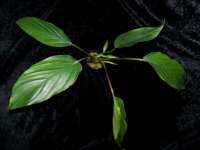
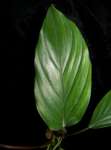
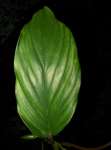
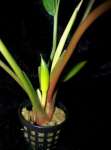
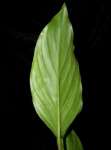
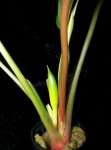

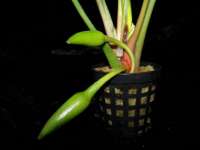
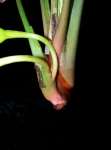

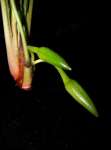
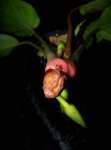
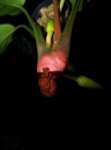
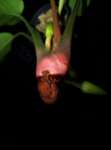
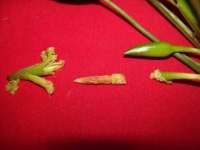
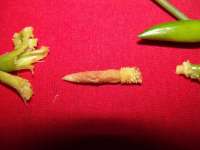
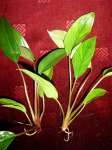
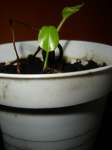
Dear Friends,
I bought an aroid in a pet shop as an aquarium plant.
I think it is a species of Homalomena or something from Schismatoglottideae from SE Asia.
The leaves are stiff, dry in touch, like the leaves of Aglaonema.
The petioles are reddish at the base (but not always).
The leaf blades are 12-17 cm long on 11-14 cm long petioles.
It produces 2 inflorescences from a node. They are 3 cm tall on 4 cm long peduncles.
When I bought it, 3 days ago, all the spathes were tightly wrapping the inflorescence.
Today one of them opened, I didn't notice when, but it didn't unroll like most aroids.
I found it detached from the peduncle, a few cm away.
The inflorescence was rotten at the base, so it fell off as I touched it.
The female flowers are about 1mm tall x 0.6 mm wide. There are no pistillodes or staminodes.
I opened also the second inflorescence,
but now I have no possibility to transfer the new photos.
The spathe is very thick, the female flowers are green
and there is an incredible amount of wet pollen on the male flowers.
I may send the photos tomorrow.
It seems the plant was brutally cut off by a "collector",
because there are no roots at all.
I hope it will recover in my small greenhouse.
The plant looks almost identically as the one that was identified as Homalomena insignis.
http://www.wschowa.com/abrimaal/araceum/homalomena/insignis.htm
I managed to rescue it, but it is still very small. This one is more robust.
(I attach 3 photos, these with dates as filenames are Hom. insignis,
these beginning from 100 are photos of the new plant)
Very Best,
Marek
| HTML +More |
------=_NextPart_001_01BB_01CB4B21.9F295080--
------=_NextPart_000_01BA_01CB4B21.9F295080 |
|
From: "Gareth Hambridge" <ghambridge at optusnet.com.au> on 2010.09.04 at 23:55:04(21382)
I'm pretty sure the specimen in the second photo is Felis catus on the shoulder of Homo sapiens.
Sorry
| HTML +More | |
----- Original Message -----
From: Marek Argent
To: discussion of aroids
Sent: Friday, September 03, 2010 12:36 PM
Subject: [Aroid-l] Fw: Homalomena or ...?
Dear Friends,
I bought an aroid in a pet shop as an aquarium plant.
I think it is a species of Homalomena or something from Schismatoglottideae from SE Asia.
The leaves are stiff, dry in touch, like the leaves of Aglaonema.
The petioles are reddish at the base (but not always).
The leaf blades are 12-17 cm long on 11-14 cm long petioles.
It produces 2 inflorescences from a node. They are 3 cm tall on 4 cm long peduncles.
When I bought it, 3 days ago, all the spathes were tightly wrapping the inflorescence.
Today one of them opened, I didn't notice when, but it didn't unroll like most aroids.
I found it detached from the peduncle, a few cm away.
The inflorescence was rotten at the base, so it fell off as I touched it.
The female flowers are about 1mm tall x 0.6 mm wide. There are no pistillodes or staminodes.
I opened also the second inflorescence,
but now I have no possibility to transfer the new photos.
The spathe is very thick, the female flowers are green
and there is an incredible amount of wet pollen on the male flowers.
I may send the photos tomorrow.
It seems the plant was brutally cut off by a "collector",
because there are no roots at all.
I hope it will recover in my small greenhouse.
The plant looks almost identically as the one that was identified as Homalomena insignis.
http://www.wschowa.com/abrimaal/araceum/homalomena/insignis.htm
I managed to rescue it, but it is still very small. This one is more robust.
(I attach 3 photos, these with dates as filenames are Hom. insignis,
these beginning from 100 are photos of the new plant)
Very Best,
Marek
_______________________________________________
Aroid-L mailing list
Aroid-L@www.gizmoworks.com
http://www.gizmoworks.com/mailman/listinfo/aroid-l
------=_NextPart_000_005A_01CB4CE0.69D345B0--
--==============)10889680954584713=� |
|
From: "Gareth Hambridge" <ghambridge at optusnet.com.au> on 2010.09.05 at 00:33:48(21384)
A total guess made without looking at any comparison photos but could it be an Anubias. These are commonly sold in the aquarium trade and have very stiff leaves.
cheers, Gareth
| HTML +More | |
----- Original Message -----
From: Marek Argent
To: discussion of aroids
Sent: Friday, September 03, 2010 12:36 PM
Subject: [Aroid-l] Fw: Homalomena or ...?
Dear Friends,
I bought an aroid in a pet shop as an aquarium plant.
I think it is a species of Homalomena or something from Schismatoglottideae from SE Asia.
The leaves are stiff, dry in touch, like the leaves of Aglaonema.
The petioles are reddish at the base (but not always).
The leaf blades are 12-17 cm long on 11-14 cm long petioles.
It produces 2 inflorescences from a node. They are 3 cm tall on 4 cm long peduncles.
When I bought it, 3 days ago, all the spathes were tightly wrapping the inflorescence.
Today one of them opened, I didn't notice when, but it didn't unroll like most aroids.
I found it detached from the peduncle, a few cm away.
The inflorescence was rotten at the base, so it fell off as I touched it.
The female flowers are about 1mm tall x 0.6 mm wide. There are no pistillodes or staminodes.
I opened also the second inflorescence,
but now I have no possibility to transfer the new photos.
The spathe is very thick, the female flowers are green
and there is an incredible amount of wet pollen on the male flowers.
I may send the photos tomorrow.
It seems the plant was brutally cut off by a "collector",
because there are no roots at all.
I hope it will recover in my small greenhouse.
The plant looks almost identically as the one that was identified as Homalomena insignis.
http://www.wschowa.com/abrimaal/araceum/homalomena/insignis.htm
I managed to rescue it, but it is still very small. This one is more robust.
(I attach 3 photos, these with dates as filenames are Hom. insignis,
these beginning from 100 are photos of the new plant)
Very Best,
Marek
_______________________________________________
Aroid-L mailing list
Aroid-L@www.gizmoworks.com
http://www.gizmoworks.com/mailman/listinfo/aroid-l
------=_NextPart_000_00A4_01CB4CE5.D380B380--
--==============496672856754529718=� |
|
From: "Marek Argent" <abri1973 at wp.pl> on 2010.09.05 at 00:54:37(21387)
Hello,
Ah, sorry - ithis photo was attached by mistake, but you should know that cats are before aroids for me ;)
This is not Felis catus, this is Felis × bellissima ssp. hortensis var. alba
Marek
| HTML +More | |
----- Original Message -----
From: Gareth Hambridge
To: Discussion of aroids
Sent: Sunday, September 05, 2010 1:55 AM
Subject: Re: [Aroid-l] Fw: Homalomena or ...?
I'm pretty sure the specimen in the second photo is Felis catus on the shoulder of Homo sapiens.
Sorry
----- Original Message -----
From: Marek Argent
To: discussion of aroids
Sent: Friday, September 03, 2010 12:36 PM
Subject: [Aroid-l] Fw: Homalomena or ...?
Dear Friends,
I bought an aroid in a pet shop as an aquarium plant.
I think it is a species of Homalomena or something from Schismatoglottideae from SE Asia.
The leaves are stiff, dry in touch, like the leaves of Aglaonema.
The petioles are reddish at the base (but not always).
The leaf blades are 12-17 cm long on 11-14 cm long petioles.
It produces 2 inflorescences from a
node. They are 3 cm tall on 4 cm long peduncles.
When I bought it, 3 days ago, all the spathes were tightly wrapping the inflorescence.
Today one of them opened, I didn't notice when, but it didn't unroll like most aroids.
I found it detached from the peduncle, a few cm away.
The inflorescence was rotten at the base, so it fell off as I touched it.
The female flowers are about 1mm tall x 0.6 mm wide. There are no pistillodes or staminodes.
I opened also the second inflorescence,
but now I have no possibility to transfer the new photos.
The spathe is very thick, the female flowers are green
and there is an incredible amount of wet pollen on the male flowers.
I may send the photos tomorrow.
It seems the plant was brutally cut off by a "collector",
because there are no roots at all.
I hope it will recover in my small greenhouse.
The plant looks almost identically as the one that was identified as Homalomena insignis.
http://www.wschowa.com/abrimaal/araceum/homalomena/insignis.htm
I managed to rescue it, but it is still very small. This one is more robust.
(I attach 3 photos, these with dates as filenames are Hom. insignis,
these beginning from 100 are photos of the new plant)
Very Best,
Marek
_______________________________________________
Aroid-L mailing list
Aroid-L@www.gizmoworks.com
http://www.gizmoworks.com/mailman/listinfo/aroid-l
_______________________________________________
Aroid-L mailing list
Aroid-L@www.gizmoworks.com
http://www.gizmoworks.com/mailman/listinfo/aroid-l
Nie znaleziono virusa w tej wiadomości przychodzącej.
Sprawdzone przez AVG - www.avg.com
Wersja: 8.5.441 / Baza danych wirusów: 271.1.1/3110 - Data wydania: 09/02/10 18:50:00
------=_NextPart_000_0221_01CB4CA5.AD4ADAF0--
--==============@84478010395973925=� |
|
From: "Gareth Hambridge" <ghambridge at optusnet.com.au> on 2010.09.10 at 23:00:48(21437)
Lucky its not Felis herbae var. voro.
I hope I got the other species right!!
Gareth
| HTML +More | |
----- Original Message -----
From: Marek Argent
To: Discussion of aroids
Sent: Sunday, September 05, 2010 10:54 AM
Subject: Re: [Aroid-l] Fw: Homalomena or ...?
Hello,
Ah, sorry - ithis photo was attached by mistake, but you should know that cats are before aroids for me ;)
This is not Felis catus, this is Felis × bellissima ssp. hortensis var.
alba
Marek
----- Original Message -----
From: Gareth Hambridge
To: Discussion of aroids
Sent: Sunday, September 05, 2010 1:55 AM
Subject: Re: [Aroid-l] Fw: Homalomena or ...?
I'm pretty sure the specimen in the second photo is Felis catus on the shoulder of Homo sapiens.
Sorry
----- Original Message -----
From: Marek Argent
To: discussion of aroids
Sent: Friday, September 03, 2010 12:36 PM
Subject: [Aroid-l] Fw: Homalomena or ...?
Dear Friends,
I bought an aroid in a pet shop as an aquarium plant.
I think it is a species of Homalomena or something from Schismatoglottideae from SE Asia.
The leaves are stiff, dry in touch, like the leaves of Aglaonema.
The petioles are reddish at the base (but not always).
The leaf blades are 12-17 cm long on 11-14 cm long petioles.
It produces 2 inflorescences from a node. They are 3 cm tall on 4 cm long peduncles.
When I bought it, 3 days ago, all the spathes were tightly wrapping the inflorescence.
Today one of them opened, I didn't notice when, but it didn't unroll like most aroids.
I found it detached from the peduncle, a few cm away.
The inflorescence was rotten at the base, so it fell off as I touched it.
The female flowers are about 1mm tall x 0.6 mm wide. There are no pistillodes or staminodes.
I opened also the second inflorescence,
but now I have no possibility to transfer the new photos.
The spathe is very thick, the female flowers are green
and there is an incredible amount of wet pollen on the male flowers.
I may send the photos tomorrow.
It seems the plant was brutally cut off by a "collector",
because there are no roots at all.
I hope it will recover in my small greenhouse.
The plant looks almost identically as the one that was identified as Homalomena insignis.
http://www.wschowa.com/abrimaal/araceum/homalomena/insignis.htm
I managed to rescue it, but it is still very small. This one is more robust.
(I attach 3 photos, these with dates as filenames are Hom. insignis,
these beginning from 100 are photos of the new plant)
Very Best,
Marek
_______________________________________________
Aroid-L mailing list
Aroid-L@www.gizmoworks.com
http://www.gizmoworks.com/mailman/listinfo/aroid-l
_______________________________________________
Aroid-L mailing list
Aroid-L@www.gizmoworks.com
http://www.gizmoworks.com/mailman/listinfo/aroid-l
Nie znaleziono virusa w tej wiadomości przychodzącej.
Sprawdzone przez AVG - www.avg.com
Wersja: 8.5.441 / Baza danych wirusów: 271.1.1/3110 - Data wydania: 09/02/10 18:50:00
_______________________________________________
Aroid-L mailing list
Aroid-L@www.gizmoworks.com
http://www.gizmoworks.com/mailman/listinfo/aroid-l
------=_NextPart_000_002C_01CB518F.D38541D0--
--==============)84057848887879873=� |
|
From: Peter Boyce <phymatarum at googlemail.com> on 2010.09.11 at 04:25:01(21439)
Dear Marek,
As I said in the email to you on the 3rd, yes, this
is a Homalomena. It is a member of the Chamaecladon Supergroup,
distinguished by small spathes that lack a constriction, but we are unable to
identify it further to species. The plant when you bought it was already mainly
in fruit (inflorescences pendent). The spathe that opened is actually abscising
from the base to reveal fruits. I notice from your images that there are still
inflorescences emerging from the middle of the plant, these have yet to flower,
and you should keep an eye these. Homalomena inflorescences open only
for a short while, usually late in the evening. Initially the spathe gapes
slightly (this is the pistillate phase). Later the spathe will open more widely
(this is the staminate) phase and then close, at which stage it looks as if it
is ready to open. A while later the peduncle will begin to bend to bring the
inflorescences to the position that most are in your images.
The good news is that these plants have certainly not been wild
collected. They are far too clean. My guess is that the originating nursery has
large mother plants and from these removed small offsets and pots separately,
leaves them for a couple of weeks to initiate roots, and then ships.
Very best
Peter
| HTML +More | |
From: aroid-l-bounces@www.gizmoworks.com
[mailto:aroid-l-bounces@www.gizmoworks.com] On Behalf Of Marek Argent
Sent: Friday, 3 September, 2010 10:37 AM
To: discussion of aroids
Subject: [Aroid-l] Fw: Homalomena or ...?
Dear
Friends,
I
bought an aroid in a pet shop as an aquarium plant.
I
think it is a species of Homalomena or something from Schismatoglottideae from
SE Asia.
The
leaves are stiff, dry in touch, like the leaves of Aglaonema.
The
petioles are reddish at the base (but not always).
The
leaf blades are 12-17 cm long on 11-14 cm long petioles.
It
produces 2 inflorescences from a node. They are 3 cm tall on 4 cm long
peduncles.
When
I bought it, 3 days ago, all the spathes were tightly wrapping the
inflorescence.
Today
one of them opened, I didn't notice when, but it didn't unroll like most
aroids.
I
found it detached from the peduncle, a few cm away.
The
inflorescence was rotten at the base, so it fell off as I touched it.
The
female flowers are about 1mm tall x 0.6 mm wide. There are no pistillodes
or staminodes.
I
opened also the second inflorescence,
but
now I have no possibility to transfer the new photos.
The
spathe is very thick, the female flowers are green
and
there is an incredible amount of wet pollen on the male flowers.
I
may send the photos tomorrow.
It
seems the plant was brutally cut off by a "collector",
because there
are no roots at all.
I
hope it will recover in my small greenhouse.
The
plant looks almost identically as the one that was identified as Homalomena
insignis.
href="http://www.wschowa.com/abrimaal/araceum/homalomena/insignis.htm">http://www.wschowa.com/abrimaal/araceum/homalomena/insignis.htm
I
managed to rescue it, but it is still very small. This one is more robust.
(I
attach 3 photos, these with dates as filenames are Hom. insignis,
these
beginning from 100 are photos of the new plant)
Very
Best,
Marek
------=_NextPart_000_01B7_01CB51AC.5D22AF10--
--==============847808563178764294=� |
| |
Note: this is a very old post, so no reply function is available.
|
|






















